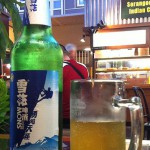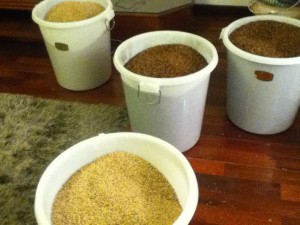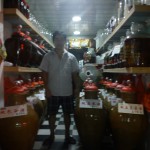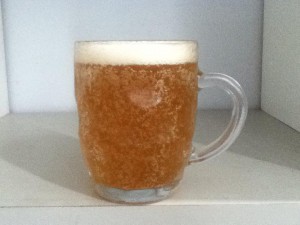While brewing in China I quickly realized that common pale ale recipes were not going to do as well as they do in the West due to the particular tastes of the local and expat beer drinking crowds. Continued trial and error led to a new, Chinese inspired pale ale recipe.
China consumes more beer than any other country on Earth, yet they are also a late adopter of the craft beer movement. In fact, in China, craft beer – even coupled with imported beer – takes up less than 1% of total beer sales. Of the 50 billion liters the Chinese population drinks every year, 99% are watery, low alcohol, low flavor lagers.
Beer Profile

This China Pale Ale (CPA) is something like a Session IPA, but with extreme flavors subdued for more delicate palates. If you love a subtle but prominent hop presence layered in front of a dry ale malt profile, you will love the CPA.
This is a low gravity beer that will not leave you wanting for flavor. The recipe below is designed for use with the Igloo Cooler mash tun.

The China Pale Ale
Batch Size: 20L (about 5 gallons)
OG: 1.045
FG: 1.006
ABV: 3.8%
IBU: 29
SRM: 4.6L
About the Mash
We quickly discovered that Chinese malt was highly inconsistent. Crystal and caramel malts were rarely recognizable by any Western standard measurement and the dark and roasted malts were almost always unusable. In fact, the only consistent factor was under-modification. What this means is: 1kg of Chinese malt would yield less fermentable sugars (and usable flavors) than 1kg of a similar Western malt.
 To counter this we had to employ some old-school mashing techniques, such as protein and beta-glucan rests as well as some seriously complicated decoction mashes. If you don’t know what this means, consider yourself lucky that modern Western malt is of such a high quality.
To counter this we had to employ some old-school mashing techniques, such as protein and beta-glucan rests as well as some seriously complicated decoction mashes. If you don’t know what this means, consider yourself lucky that modern Western malt is of such a high quality.
Eventually we discovered a source of good quality, reliable malt – but by then our recipes and techniques had been able to produce a relatively popular brew in the small area we were supplying. And so, I eventually developed the following mash schedule to incorporate maximum efficiency, resulting in a very dry but delicious session ale.
The mash-in occurs at 49°C (120°F) and is raised to the initial saccharification rest of 66°C (151°F) over the course of ten minutes. This activates plenty of enzymes needed to break down complex proteins chains – or, more simply put, creates a pleasing dry beer with a minimal grain bill.
There is also an extra-long boil to break up any residual proteins or starches and get the most out of the bittering hops despite the low boil gravity.
The CPA Recipe
This recipe has, I am proud to say, had some influence on the craft beer scene of modern  Canton. Whether the CPA style takes off across the rest of China or any other part of the world has yet to be seen.
Canton. Whether the CPA style takes off across the rest of China or any other part of the world has yet to be seen.
Enjoy!
Water Treatment:
- 0.5g Calcium Chloride
- 0.25g Gypsum
Please note that the water treatment is minimal – in fact you may be able to skip this entirely if you have a good starting water profile in your current location.
Grain:
- 3kg (6.6 pounds) German Pilsner malt
- 0.4kg (0.88 pounds) Munich 1
- 0.2kg (0.44 pounds) Melanoidin
Hops:
- 8g (0.3 oz) Nugget @ 13% AA (75 minutes – bittering)
- 20g (0.7 oz) Cascade @ 7% AA (30 minutes – bittering / flavor)
- 20g (0.7 oz) Cascade @ 7% AA (0 minutes – aroma)
- 28g (1 oz) Mosaic @ 7% AA (dry hop)
- 12g (0.4 oz) Amarillo @ 8% AA (dry hop)
Mash Schedule:
- Mash in at 49°C (120°F)
- Over ten minutes, raise to 66°C (151°F)
- Hold at 66°C (151°F) for 60 minutes
- Raise to 72°C (162°F) and hold for ten minutes
- Raise to 78°C (172°F) and begin lauter (mash out)
 Finings:
Finings:
- 5g Irish Moss (five minutes)
Yeast:
- California Ale (US05, WLP 001 or WY1056)
Fermentation:
- Pitch at 22°C (71.6°F)
- Yeast off (or rack to secondary) when gravity reaches 1.009 or lower
- Dry hop immediately after racking
Packaging:
- Keg or bottle to standard carbonation levels once clarity is achieved.
If you’re interested in exploring other surprising brewing beer ingredients click here.
WARNING:
 This beer tastes especially good in the hot, tropical humidity of a South-East Asian Summer. The low alcohol content is especially refreshing – right up until you drink eight of them and it all suddenly hits you.
This beer tastes especially good in the hot, tropical humidity of a South-East Asian Summer. The low alcohol content is especially refreshing – right up until you drink eight of them and it all suddenly hits you.
Please don’t be fooled: this is a low alcohol beer, but it’s very more-ish. It’ll creep up on you before you know it. Please drink it responsibly.
CHEERS!
I hope you enjoy this China Pale Ale. This was the work of a lot of trial and error in an untested market, and eventually produced a really unique offering in the modern Chinese craft beer world.
This recipe is modified for homebrewers using an Igloo Cooler mash tun. Please click here to find more details on this system.
 If you have any questions, comments, or feedback, please let me know in the comments below!
If you have any questions, comments, or feedback, please let me know in the comments below!






Cheers Jesse,
I like to try a good beer recipe. Despite that I did not know that the people of China is the largest consumer of beer.
I’ve never made a beer but I think with the help of the Igloo Cooler Mash Tun and your recipe I will achieve.
Thanks for sharing this great information.
renan
Hi Renan,
Thank you for your comments. I was surprised myself, even more surprised to learn that the largest selling beer in China is relatively unheard of – Snow Beer!
The Igloo Cooler Mash tun should be ideal – please let me know if you want to use another set of equipment, if that’s what you have on hand – I’ll be happy to help with this recipe.
The Chinese Pale Ale Recipe looks like it can create one hell of a beer. I am a big beer drinker and it is just so nice to drink one during the hot summer.
I like the fact that this beer does not have that much alcohol because I like to drink a couple before I get drunk.
It is certainly popular there now!
I hope I can get some more popularity behind the concept, it is really a good way to go – full flavour without excessive intoxication. Why not try making a batch? If you are interested I’ll try to make an extract version!
Hi Jess,
Now that caught my attention! I have not seen a pale ale in years any where!. Sadly craft beer not really practiced in Spain or in Thailand for that matter.
I love popping by this site a seeing some new recipes for beer making, a hobby I’d love to take up when I have a little more time. I have a desire to make s craft beer with lemon grass! So refreshing for the hot weather.
Pale ale..not something I have tried since I last lived in Scotland, some 16 years ago!
Hi Derek,
Thanks for your comment, glad to hear you still have the passion!
For a lemongrass beer, I recommend you try a wheat beer and go easy on the lemongrass as a finishing hop – just follow This Link and replace the finishing hops with about half an ounce of lemongrass!
Chinese Pale Ale sounds interesting. I have a friend who home brews with me, I will have to recommend your recipe on to him. He’d love this recipe! I really like your easy to follow “How To” guide. I think I could even do this by myself!
Thanks for an interesting and entertaining website!
Thanks for your feedback Diana. I’m glad you enjoyed the recipe.
This is a great review on how to brew a pale ale. I am amazed at the inconsistencies in their malt versus ours here in North America and also how small the craft beer movement currently is in China.
I think it is great how you have described your process in developing this beer and laid out the exact recipe to obtain it. The page is put together very well.
I’ll be sharing this with a buddy at work as well.
Thanks!
Thanks very much, Adam.
I hope your buddy likes the recipe!
Dear Sir,
Thank you for great information! I just wonder what is different beer flavors between south and north China, like southern Pear River and northern Tsingtao? Is Tsintao typical CPA as well?
Best regards!
Hi Peter,
TsingTao was originally based on a traditional German style lager! These days, it varies widely from region to region due to the number of TsingTao breweries across the country.
I have actually visited the Pearl River brewery in Guandong – very clean, very high tech.
I usually focus on craft beer, and in that respect I am usually more impressed with Northern breweries – but that is not always the case! In particular, the previous brewmaster from Kingway can make some very tasty craft brews 🙂